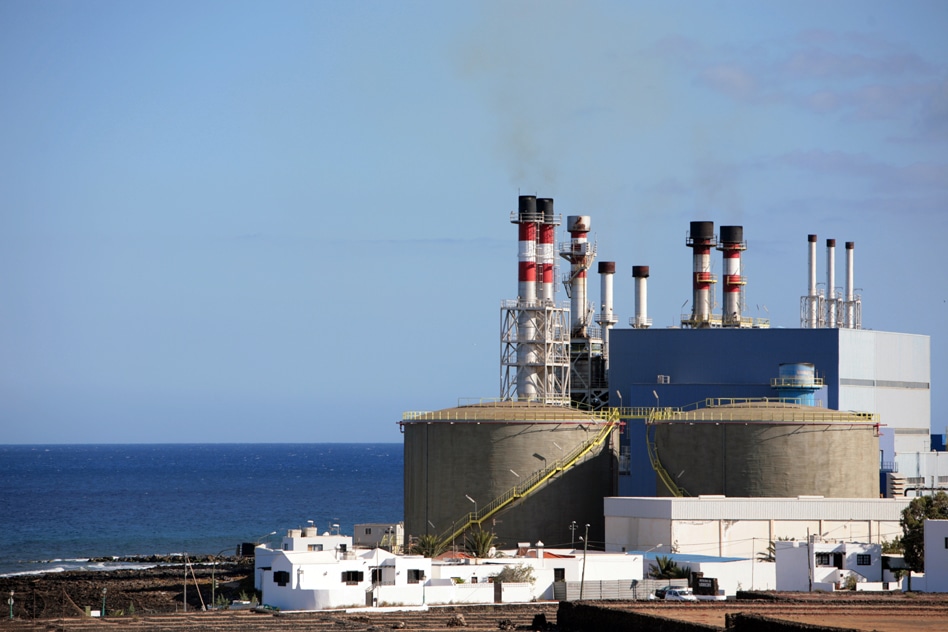Feb 14 2019
In the fast-evolving desalination industry, water is produced for drinking as well as for agriculture in the barren coastal regions of the world.
 Seaside desalination plants like this typically discharge large volumes of concentrated brine back into the sea. MIT researchers have shown that instead, much of this waste could be turned into useful chemicals. (Image credit: MIT)
Seaside desalination plants like this typically discharge large volumes of concentrated brine back into the sea. MIT researchers have shown that instead, much of this waste could be turned into useful chemicals. (Image credit: MIT)
However, the by-product is a large quantity of highly concentrated brine, which is normally discarded by throwing it back into the sea—a process that demands expensive pumping systems and that must be handled cautiously to avoid damage to marine ecosystems. Currently, engineers at MIT have stated that they have discovered an enhanced method.
As part of a new research, they demonstrate that the waste material can be turned into useful chemicals—including those that can render the desalination process itself more efficient—through a quite straightforward process.
The method can be used to synthesize sodium hydroxide, apart from other products. Also called caustic soda, sodium hydroxide can be used for the pretreatment of seawater entering the desalination plant. This alters the acidity of the water, which helps prevent clogging of the membranes used to filter out the salty water—the main cause of failures and interruptions in typical reverse osmosis desalination plants.
The concept has been reported in the journal Nature Catalysis on February 13th, 2019 and in two other papers by Amit Kumar, MIT research scientist, John H. Lienhard V, professor of mechanical engineering, and many others. Lienhard is the Jameel Professor of Water and Food and also the director of the Abdul Latif Jameel Water and Food Systems Lab.
The desalination industry itself uses quite a lot of it. They’re buying it, spending money on it. So if you can make it in situ at the plant, that could be a big advantage.
Amit Kumar, Research Scientist, MIT
The quantity required in the plants themselves is too less when compared to the total amount that could be synthesized from the brine, hence there is also a possibility for it to be a marketable product.
In addition to sodium hydroxide, several other products can also be produced from the waste brine—including hydrochloric acid, an important chemical used in desalination plants and several other industrial processes, which can be easily produced on site from the waste brine using recognized chemical processing techniques. It is possible to use the chemical to clean parts of the desalination plant; it is also extensively employed in chemical production and as a source of hydrogen.
Presently, over 100 billion liters (approximately 27 billion gallons) of water are produced per day from desalination across the globe, leaving an equivalent volume of concentrated brine. Most of it is pumped back out to sea, and existing regulations demand expensive outfall systems to make sure that the salts are adequately diluted. Therefore, converting the brine can be advantageous both ecologically and economically, particularly because desalination keeps evolving quickly around the world.
Environmentally safe discharge of brine is manageable with current technology, but it’s much better to recover resources from the brine and reduce the amount of brine released.
John H. Lienhard V, Professor, Department of Mechanical Engineering, MIT
The process of converting the brine into useful products employs established and standard chemical processes, such as initial nanofiltration to eliminate unwanted compounds, and then one or more electrodialysis stages to produce the desired end product. Although the proposed processes already exist, the scientists have analyzed the possibility of producing useful chemicals from brine and suggested a definite combination of products and chemical processes that could be transformed into commercial operations to improve the economic viability of the desalination process, while minimizing its effect on the environment.
“This very concentrated brine has to be handled carefully to protect life in the ocean, and it’s a resource waste, and it costs energy to pump it back out to sea,” so turning it into a useful commodity is a win-win,” stated Kumar. And sodium hydroxide is such a ubiquitous chemical that “every lab at MIT has some,” he says, hence finding markets for it must be easy.
The scientists have discussed the idea with companies that may have an interest in the next step of constructing a prototype plant to aid in solving the real-world economics of the process. “One big challenge is cost—both electricity cost and equipment cost,” at this point, states Kumar.
Furthermore, the researchers continue to analyze the potential of deriving other, lower-concentration materials from the brine stream, including different metals and other chemicals, which could allow the brine processing to be a much more economically feasible mission.
One aspect that was mentioned and strongly resonated with me was the proposal for such technologies to support more ‘localized’ or ‘decentralized’ production of these chemicals at the point-of-use. This could have some major energy and cost benefits, since the up-concentration and transport of these chemicals often adds more cost and even higher energy demand than the actual production of these at the concentrations that are typically used.
Jurg Keller, Professor of Water Management, University of Queensland, Australia
However, Jurg Keller was not a part of this research.
The research team also included MIT postdoc Katherine Phillips and undergraduate Janny Cai, and Uwe Schroder from the University of Braunschweig, in Germany. Cadagua, a subsidiary of Ferrovial, supported the research through the MIT Energy Initiative.